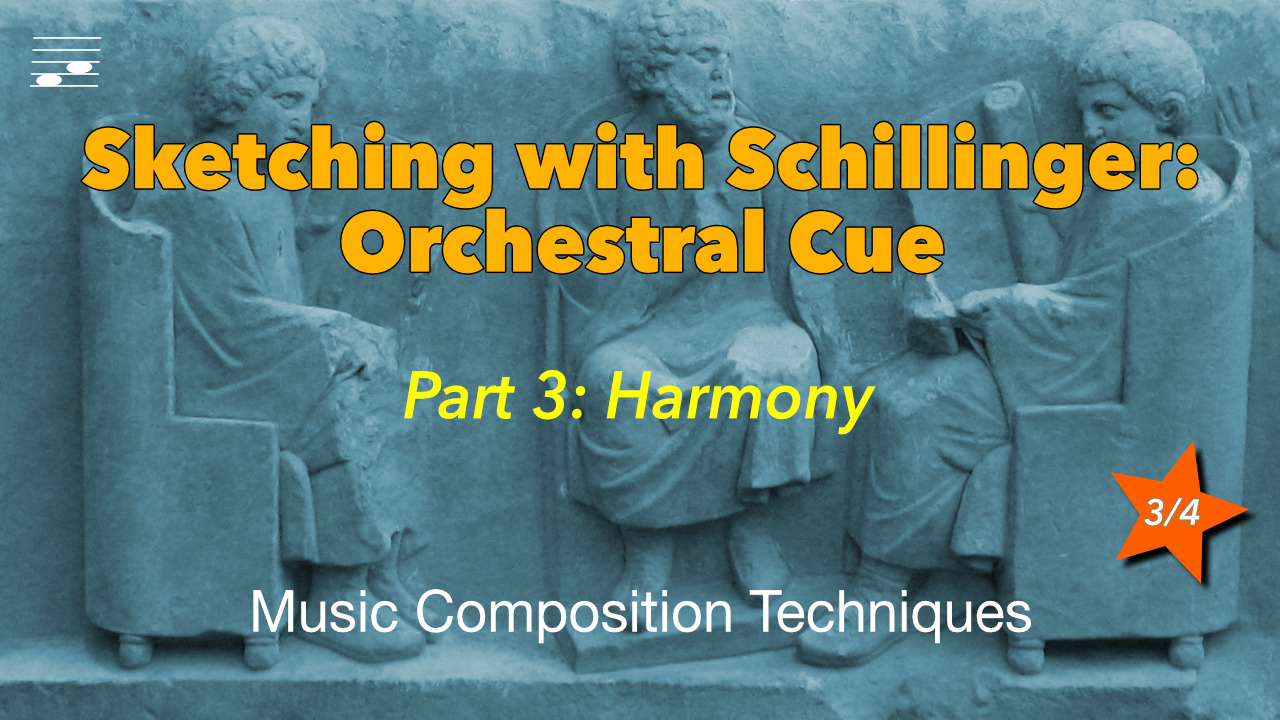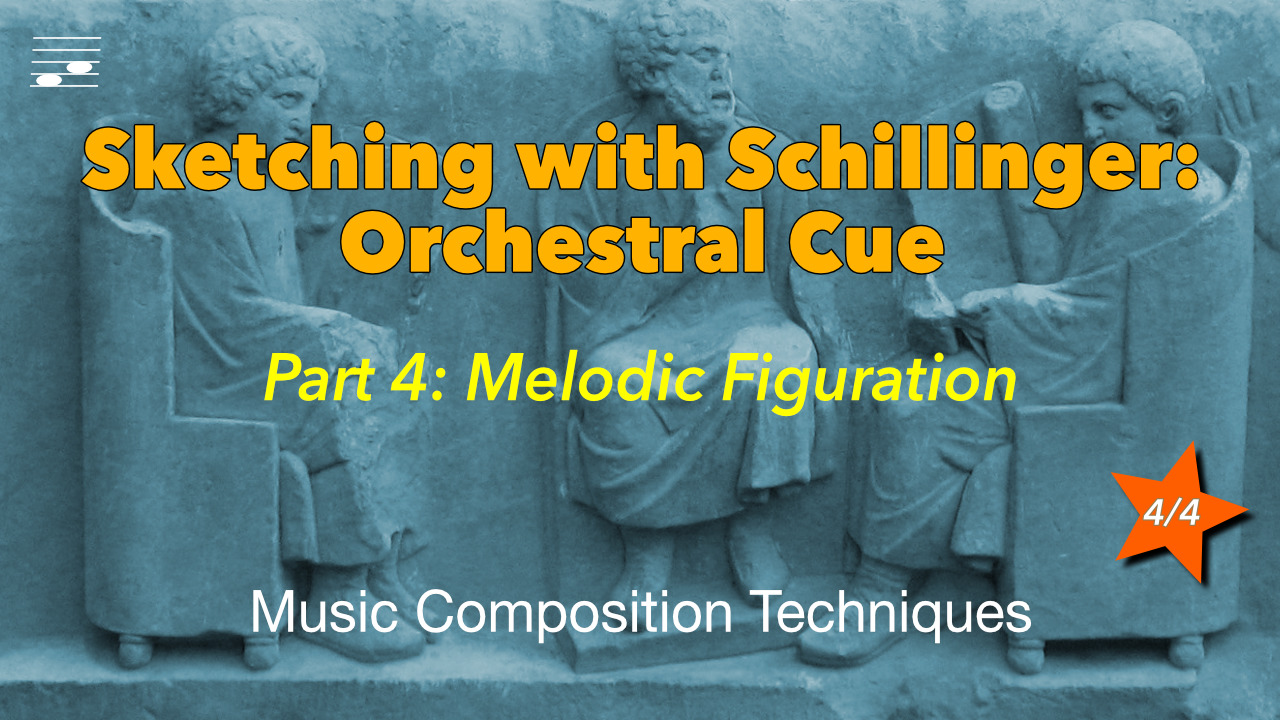Homepage > Composition > Music Datasheet
"Sketching with Schillinger"
| GENERAL INFORMATION | |
|---|---|
| Title | Sketching with Schillinger |
| Composer | F.G.J. Absil |
| Instrum. | Studio Orchestra |
| Date | November 2022 |
| Duration | 4'10 |
| Style | Synthesizer and Orchestral Music |
| Key | A minor, atonal |
| Meter | 4/4, 3/2 and 3/4 |
| Measures | 116 |
| Tempo | 100 - 216 - 112 -72 BPM |
FULL INSTRUMENTATION

- Woodwinds: Piccolo, Flute 1-2, Oboe 1-2, English Horn, Clarinet in Bb 1-2, Bass Clarinet, Bassoon 1-2;
- Brass: Horn in F 1-2-3-4, Trumpet 1-2-3, Trombone 1-2, Bass Trombone, Tuba;
- Percussion: Timpani, Bar Chimes, Bass Drum, Snare Drum, Piatti, Suspended Cymbal, Tam-tam, Toms, Triangle;
- Harp, Piano, Celesta, Marimba, Xylophone, Keyboard 1-2;
- Strings: Violin 1, Violin 2, Viola, Cello, Double Bass.
PERFORMANCE NOTES
 This composition 'Sketching with Schillinger' is written as an example for a set of four YouTube video tutorials about writing music with the Schillinger System of Musical Composition.
You'll see various Schillinger System techniques applied to a three-pitch melodic cell.
This composition 'Sketching with Schillinger' is written as an example for a set of four YouTube video tutorials about writing music with the Schillinger System of Musical Composition.
You'll see various Schillinger System techniques applied to a three-pitch melodic cell.
 Here are the YouTube links:
Sketching with Schillinger: Orchestral Cue Part 1 Composition Overview (12:14),
Sketching with Schillinger: Orchestral Cue Part 2 Melody and Rhythm (23:25),
Sketching with Schillinger: Orchestral Cue Part 3 Harmony (38:55),
Sketching with Schillinger: Orchestral Cue Part 4 Melodic Figuration (24:33).
Here are the YouTube links:
Sketching with Schillinger: Orchestral Cue Part 1 Composition Overview (12:14),
Sketching with Schillinger: Orchestral Cue Part 2 Melody and Rhythm (23:25),
Sketching with Schillinger: Orchestral Cue Part 3 Harmony (38:55),
Sketching with Schillinger: Orchestral Cue Part 4 Melodic Figuration (24:33).

- The form of the composition is A-B-C-D, (mm. 1-25, 26-74, 75-95, and 96-116, respectively) with a slow suspenseful opening section, a fast B-section with riffs and increasing tension, then another slower C-section, and closing with a main theme D-section in melancholic mood.
- From the melodic cell C-D-Eb, i.e., Pitch-Class Set I3(3-2), through permutation and combination melodic forms and a melodic continuity are derived. There is also melodic inversion, see the D-section. The melodic form is used as a 16th note riff in the B-section. This is synchronized with a rhythm based on the non-uniform binary synchronisation rf(4,3)=3t+t+2t+t+t+t+t+t+2t+t+3t fractioning attack-duration series, with split-unit groups. Also there is rhythmic augmentation (time-unit doubling, triplets).
-
 The harmony uses both diatonic chords in 3rds (in the key of C minor) and atonal voicings. Here we find variable density with four-part and strata harmony settings with different closed (cluster) and open position voicings. The A-section strata harmony phrases use two layers with coupling (exact parallel chords in perfect 5ths) and contrary motion. Some phrases use upper part or bass pedal point.
The harmony uses both diatonic chords in 3rds (in the key of C minor) and atonal voicings. Here we find variable density with four-part and strata harmony settings with different closed (cluster) and open position voicings. The A-section strata harmony phrases use two layers with coupling (exact parallel chords in perfect 5ths) and contrary motion. Some phrases use upper part or bass pedal point. - The audio rendering of the Cubase 11 Midi mockup uses Aaron Venture Infinite Woodwinds and Brass libraries, Spitfire Audio BBC Symphony Orchestra Percussion, Audio Modeling SWAM solo violin, and Sample Modeling Ensemble Strings. Synthesizers are from the Native Instruments Komplete Collection. Effect plug-ins are Steinberg stock, FabFilter, LiquidSonics, Valhalla DSP, and Nugen Audio.
Additional Material:
- Full score: Read the score >> (PDF full score, A3 format, portrait, 12 pp.)
- Companion document: Sketching with Schillinger, Orchestral Cue available on my Patreon page (PDF, A4, 79 pages). Text, diagrams and reduced score examples.
- Watch the corresponding YouTube video tutorials:
Sketching with Schillinger: Orchestral Cue Part 1 Composition Overview (12:14)
Sketching with Schillinger: Orchestral Cue Part 2 Melody and Rhythm (23:25)
Sketching with Schillinger: Orchestral Cue Part 3 Harmony (38:55)
Sketching with Schillinger: Orchestral Cue Part 4 Melodic Figuration (24:33).
